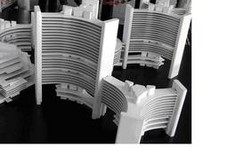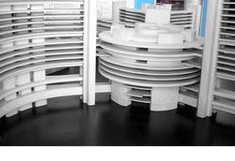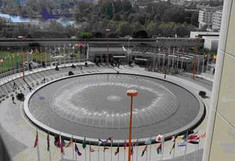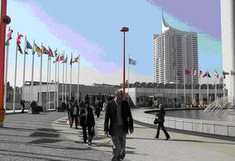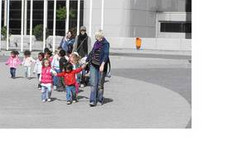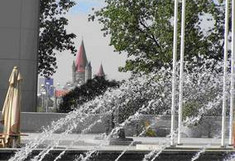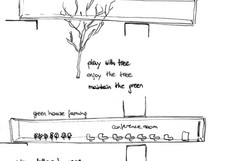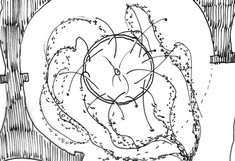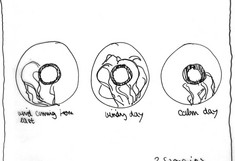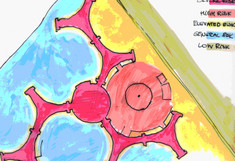The Workshop Site
A City Garden for a Changing World
A One-day Ideas Workshop
The Workshop Site
The Forecourt of the United Nations Centre in Vienna (VIC)
Workshop Process
Design Response for UNO City Garden
Relevant UN Charters and Policies for the Workshop
The Workshop Site
The Forecourt of the United Nations Centre in Vienna (VIC)
Background In 1966, the Government of Austria made an offer to the United Nations to construct in Vienna an international centre United Nations. on the left bank of the Danube designed by the Austrian architect Johann Staber. The VIC complex, which covers an area of 180,000 m², has extraterritorial status. It accommodates about 3,600 international civil servants from about 100 countries. The Y-shaped office towers reach 120 meters. A vast circular forecourt announces the member nations with a ring of flags.
Model of UN, Vienna | Elevated above by pilotis | |
View to park and Danube | people in the forecourt | |
visiting children | modern meets old |
Virtual Tour of the United Nations Centre in Vienna http://www.unvienna.org/unov/en/vtour/index.html Workshop Schedule
| 8.30 pm Meet at UN Plaza | 1.00 - 3.00 pm Groups work up premliminary concepts |
| 10.30 pm Ath the BOKU, begin presentations of participants' selected cities | 3.00 pm afternoon tea/coffee |
| 12.00 pm Agree on criteria for City Gardens of the Future Collectively develop brief for 21st C City Garden for UN | 4.15 - 6.00 pm Develop final conceptual designs for exhibition |
| 12.30 pm Select groups (2 - 3) depending on numbers) Get to know group members over lunch |
Workshop Process The central ideas that emerged from the individual concept boards were discussed leading to a number of possible approaches for a hypothetical concept design for ‘A City Garden for a Changing World’ using United Nations in Vienna as a notional site. How did individual city concepts link to the forecourt of United Nations? United Nations, as a symbolic place, allowed the participants to contrast the ‘particularities’ of the cities itemised above with the ‘universals’ associated with a global organisation; addressing the conference theme DOES SCALE MATTER? Relevant extracts from the UN Charter and selected policies were considered. Through actively exploring the ‘particular’ and the ‘universal’ using conceptual designs as the tools, the workshop developed criteria for a ‘City Garden for a Changing World’, addressing the conference theme HOW CAN LANDSCAPE BE A MODEL?
| Central Ideas from shrinking and growing cities | Issues and Concepts for UNO city garden |
Let voids become people’s Common Ground | UN -International organisation |
| Use the concept of ‘field’ as the organiser of space | UN -Concerned with harmonious cities |
| Make green corridors through abandoned land | UN-Concerned with global food security |
| Use desire lines to create city as a garden | UN - Concerned with sustainable human settlements |
| Develop horticultural zones | |
| Develop experimental zones | VIC plaza – high security |
| Create infrastructure gardens | Concept – potential layers |
| Make micro-gardens in streets | Concept – develop agriculture zones |
| Develop mobile garden centres for micro-gardens | Concept – reveal pilotis |
| Develop soil-less food generators on wastelands | Concept -Respect original design at ground level |
| Use compressed rubbish as a building material | Concept – harness wind and sun |
| Create ‘illusional’ gardens on media screens in slums | Concept – outdoor website screens |
| Work with diffuse city not congested city | Concept – provide visual link to park |
Proposal: a city garden for a changing world - MEMORIAL PLAZA UNO VIENNA A city garden can be more than a park. It can reveal local identity but it can also celebrate the future, revive horticultural/agricultural traditions, be a playful place exploring all the senses, be an empowering place for diverse communities, be a catalyst for eco-design and engaged citizenship and a place of hope while elevating the soul.
Glazed recreational boxes to connect building and plaza to surroundings

Glazed boxes to contain bubbles for individual napping and recreation


City garden should playfully explore all the senses




Sculptural wind turbines as symbols of renewable energy City garden can revive horticultural and agricultural traditions
- creating leisure zones in gardens
- self-made gardens for everybody to grow food and flowers
City garden can be a catalyst for eco-design and engaged citizenship Hanging Mobile Gardens Mobile agriculture gardens moving up an down the façade of the main UNO building; micro-gardens infiltrating the building



Making gardens as living art with high visibility City garden can be an empowering place for diverse communities
Micro-gardens from around the world
High visibility send a message around the world about feeding people
City garden can be a place of hope while elevating the soul.
- Water in the Fountain Plaza – individual and unpredictable – symbol of difference and coming togetherInside the UNO-City different rules are important and respected.
- The plaza fountain is now following the rules,
- But the water should be free and unpredictable because UNO-City is a special meeting place.
- The water stands for different nationalities and individuals where the unpredictable fountain sprinkles water everywhere.
City garden can be a place of hope for an international community
- The loss of forests and water pollution is a common environmental pre-occupation that is putting our cities and planet in danger
- The UNO-City garden celebrates a better future through eco-design
- It engages all the UNO community
- An arc of trees and shrubs symbolises reclaiming the forests. Experimental agriculture strips slope towards the water
- A musical ‘forest’ of pillars surrounds the water and changing sculptures are scattered on the slopes


The UNO-City Garden as Symbol of Food Security
| Food security risks | Food security opportunities |
|---|---|
| Food Sovereignty | Self-administered DIY and micro-gardens |
| Voids as people’s common ground for food production |
| Desire lines as connections between articulated spots and security zones |
| Green Corridors / Ecological connections |
Severe risk - self-focusedLow risk - wind/energy crops Relevant Charters and Policies: United Nations Charter www.un.org/aboutun/charter/
CHAPTER IX: INTERNATIONAL ECONOMIC AND SOCIAL CO-OPERATION Article 55 With a view to the creation of conditions of stability and well-being which are necessary for peaceful and friendly relations among nations based on respect for the principle of equal rights and self-determination of peoples, the United Nations shall promote:
- higher standards of living, full employment, and conditions of economic and social progress and development;
- solutions of international economic, social, health, and related problems; and international cultural and educational cooperation; and
- universal respect for, and observance of, human rights and fundamental freedoms for all without distinction as to race, sex, language, or religion.
1. UNHABITAT- World Urban Forum 4, Harmonious Urbanization Nov 2008, Nanjing China http://www.unhabitat.org/downloads/docs/6141_42168_BACKGROUNDPAPERFINAL.pdf 2. UNHABITAT – State of the World Cities 2008/2009 Harmonious Cities Part 1: Spatial Harmony Part 2: Social Harmony, Slums, the Good, the Bad and the Ugly Part 4: Planning for Harmonious Cities http://www.unhabitat.org/pmss/listItemDetails.aspx?publicationID=2562 3. UN Task Force on Global Food Security Crisis http://www.un.org/issues/food/taskforce/ 4. UN Peace Building Architecture: www.un.org/peace/peacebuilding/ 5. Agenda 21: Ch 7 Promoting Sustainable Human Settlement Development; Item C. Promoting sustainable land-use planning and management http://www.un.org/esa/sustdev/documents/agenda21/english/agenda21toc.htm 6. UN Millennium Development Goals Goal 7: Ensure environmental sustainability www.un.org/millenniumgoals

